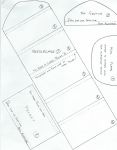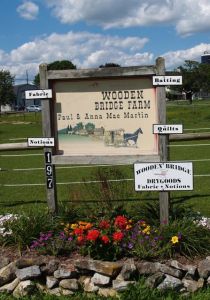When is a huswif a huswif? A house wife living between A. D. 1100 and 1500, when middle English was spoken, was known as a huswif. In the same time period a huswif or more commonly a hussy referred to a mischievous, impudent, or ill-behaved girl. However, house wives were a frugal lot, and as time progressed, the use of huswif for a penny-wise housekeeper supplanted the less savory meaning of hussy. By the eighteenth century as an extension of feminine thrifty management, sewing rolls containing scissors, thread, needles, and other sewing notions were aptly known as huswifs, a term generally recognized and used by all.
Girls, in anticipation of their duties as wives and mothers, were taught to do plain, as well as sometimes fancy sewing. Once married, they would be expected to make all the clothing, the pillow cases, bed sheets, tablecloths, fancy show towels, butter cloths by hand. By taking odds and ends of different fabric and using basic stitches such as the back stitch, basting stitch, hemming stitch, and blanket stitch, young women created a practical, yet lovely and colorful storage place for their sewing tools.
Pennsylvania Dutch girls and their mothers carried their huswifs in the large tie-on pockets or Taschen they wore under their skirts. During the Civil War women sent their men into battle with huswifs so that they could sew on buttons and mend their uniforms. The sewing roll also reminded the lonely soldier of his sweetheart or wife. It was not unusual for a man to reciprocate, and make a special huswif for his loved one, which he had sent to her as a token of his steadfastness and regard.
We also find literary references to a huswif in Jane Austen’s Sense and Sensibility (Chapter 38, 1811): “And for my part, I was all in a fright for fear your sister should ask for the huswifes she had gave us a day or two before….” Women continue to create similar rolls today not only in order to store their sewing/embroidery tools, but also to keep their jewelry or toiletries.
Two examples from the Winterthur Needlework Collection will show the variety and usefulness of the Huswif. The provenance of the first example (1960.0196) is unknown but was probably created in England; is made of cotton and linen sometime between 1780-1800; and is 19 (H) x 5 inches.
- ILL. 1 Huswif recto (1960.0196), courtesy of Winterthur Museum
- ILL. II Huswif verso (1960.0196), courtesy of Winterthur Museum
Three of the pockets are block printed, and one plate printed. The latter is a fragment depicting a rider on horseback shooting a gun, and is taken from the “Storming of Quebec” fabric of 1775.
- ILL. III Huswif pocket (1960.0196), courtesy of Winterthur Museum
The provenance of the second example (1969.3107) is Henry Francis du Pont/United States; is made of cotton, wool, and silk between 1795-1829; and is 17 (H) x 3.75 inches. There appear to be four pockets done in assorted materials on a common background, along with four semi-round pieces of wool placed at the top of the huswif to store needles.
- ILL. IV Huswif recto (1969.3107), courtesy of Winterthur Museum
- ILL. V Huswif verso (1969.3107), courtesy of Winterthur Museum
It is more usual to find these “needle keepers” at the bottom of the roll than at the top. A tie at the top is used to hang the huswif on a wall when not in use.
- ILL. VI Huswif “needle keepers” close-up (1969.3107), courtesy of Winterthur Museum
Making a huswif is not difficult. Any person who can use a needle and thread can do the following four basic stitches, and cut out the pattern to create a huswif.
- ILL. VII Huswif pattern, courtesy of Sandra Highouse
- ILL. VIII Backstitch, courtesy of Hemmadesign
- ILL. IX Basting stitch, courtesy of Creativewingtips
- ILL. X Hemming stitch, courtesy Stitchpiecepurl.com
- ILL. XI Blanket stitch, courtesy of HolidayCraftsandCreations
Calico, as well as a variety of other fabric and sewing tools can be found at Ladyfingers, a sewing studio owned by Gail Kessler in Oley, PA that caters to quilters.
- ILL. XII Ladyfingers, courtesy AlyssumArts
- ILL. XIII The Wooden Bridge, courtesy AlyssumArts
Wool for the “needle keepers,” a wide choice of materials, including calico, and a large variety of sewing notions can be found at The Wooden Bridge, a dry goods store owned by Paul and Anna Mae Martin in Kutztown, PA that also offers quilting and sewing classes, not to mention a repairman for sewing machines, and a top-notch scissors sharpener!
Both shops maintain a friendly competition, and recommend each other to their customers when unable to supply an item. Their staffs are friendly, and mega-helpful. Should you have a quilting or sewing project—such as a huswif—in mind, it’s worth a trip through gorgeous Berks County to experience the shops’ beautiful settings, ample supply of practically every quilting or sewing need you may have, and a truly knowledgeable and helpful group of salespeople to serve you.
To get a preview of what that means, take a look at the following steps I used to make this huswif.
My thanks to Linda Eaton and Roberta Weisberg of Winterthur, Lynne Bassett, and Sandra Highouse of the Goschenhoppen Historians.
© Del-Louise Moyer 2015














Excellent! I knew nothing of the Huswif; learned something new. Also I much enjoyed rereading your fine research on Elisabet Mertz and her birth record Fraktur. Many thanks!
LikeLike
A wealth of information ; Thank You for sharing all of this . Who would know. My needles are sharpened , Del Louise shared her newly hand created Huswif with me . What craftsmanship !!! Absolutely beautiful FIVE STARS*****
LikeLike
Thanks so much. Very interesting!
LikeLike
This is wonderful – thank you for your research.
LikeLike
You present beautiful illustrations and fine research! Thanks for sharing this information in such a pleasing manner.
LikeLike
What beautiful needlework! And a reminder of how much time was spent on making simple things (including textiles) in past societies! I’ll bet there were stories behind each piece of patchwork – whose dress or waistcoat the scraps came from, what shopping trips occasioned finding the fabrics… as indeed your own experience, so nicely illustrated here, has shown! Thank you, and I look forward to seeing your demo at the Goschenhoppen Historians Festival!
LikeLike
Hi Del-Louise! It was nice meeting and chatting with you at the Goshenhoppen Festival today! It was my first time attending and I really enjoyed it. I love your huswif and can’t wait to get started on making one of my own.
LikeLike
Hi Del-Louise, It was wonderful meeting you at the Goshenhoppen Festival earlier this month. I loved reading about the Huswif that we saw you making. Thank you so much for enlightening me further about this. I’m sharing this on my Facebook page. 🙂
LikeLike
Fascinating article, Thanks. My Russian immigrant great-grandmother gave my mother her collection/ roll of sewing needles in her last years, as a memento of her days as a stitcher in the garment industry in NYC. in the early 1900’s. I also enjoyed your background article on PA Germans. Well done!
LikeLike
Who has the collection roll of sewing needles now? Treasures and memories passed on from one generation to another…aren’t we all so lucky to be able to reach back in time with those memories!
LikeLike